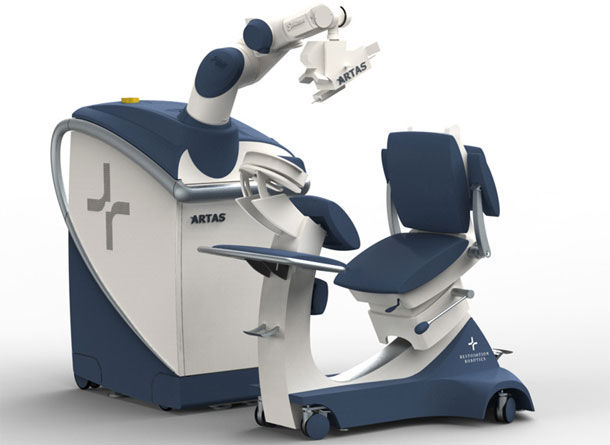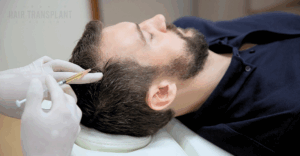ARTAS Hair Transplant Robot vs. THTS’s FUE Technique
Restoration Robotics, a company founded by Dr Frederick H. Moll, developed the ARTAS System. This completely automated machine is the first robot designed to carry out the scoring aspect of the FUE hair transplant procedure.
HOW ARTAS WORKS: THE MECHANICS
Cameras, colour identification sensors, and 3-D imaging software guide the robotic arm of ARTAS in selecting which follicles to score. To carry out the rest of the FUE process, ARTAS employs a needle punch mechanism, disposable dermal punches, disposable cartridges, a video imaging system and a user interface.
The patient is positioned for the robot to punch out the grafts on a donor area of roughly 5 to 10 cm at a time. During this time, the patient must remain absolutely still, and the head is restrained by straps. After this, the surgeon removes each graft by hand with a pair of forceps. The patient is then repositioned for ARTAS to work on a new section of donor hair. This process continues until the extraction portion of the surgery is complete. The implantation of grafts to the bald area is done using a traditional transplant approach.
POTENTIAL PROS OF ARTAS
The thought of a machine extracting FUE grafts is an attractive one if the machine can replicate the touch of an expert human practitioner, and if it can boost the speed of the extraction process.
In the opinion of both our skilled and experienced surgeons, this robot may work for doctors who wish to provide FUE, but don’t have the experience to do it manually or with a power punch.
CONS OF ARTAS OVER THTS’s FUE TECHNIQUE
- Higher Transection Rate. The Artas Robot has a transection rate (destroyed grafts) of 8 to 10%. Both Dr Huber and Dr Jones’ transection rate is 3 to 5%. Artas charges the doctor for all the destroyed grafts as well as the viable grafts, so many doctors plant these destroyed grafts knowing they won’t grow. Dr Huber and Dr Jones know the difference and with medical integrity – only charge for and plant viable grafts.
- Slower Rate of Extraction. The robot currently extracts about 600 grafts per hour, whereas both our doctors – Dr Huber and Dr Jones can extract 1,500 to 2,000 grafts per hour, enabling them to do 3,000 and even 4,000-graft sessions in a single day.
- Larger Punch. The Artas system uses a punch with a diameter of 1.65 mm, and our doctors use punches from .7 to .9 mm. A smaller punch means faster healing of the donor area, and there is less likely to be damage to surrounding grafts.
- More Likelihood of Buried Grafts. The Artas robot uses a dull punch system, which has been shown to be more likely to bury some of the grafts and cause cyst formation.
- A Robot Cannot Select Grafts for an Individual Patient. Any automated device will still have limitations in discerning the best follicle for extraction. For example, it is important to select donor hairs with a specific hairline or eyebrow design in mind. It is difficult for a machine to do this, whereas Dr Huber or Dr Jones can pick and choose different size grafts depending on the patient’s needs.
- Limited Donor Site. The Artas System is limited to areas that the square device can fit on (i.e. a strip around the back of the head). Dr’s Huber and Jones are able to extract from all permanent areas, including the sideburns, the beard or any other area of the body they choose.
- The Need to Shave the Head. With the Artas System, the physician has to shave the patient’s head, where Dr Huber and Dr Jones can perform an FUE procedure with limited or in some cases no shaving.
- Limited Hair Characteristics. ARTAS is only approved for use on patients with straight hair that is dark brown or black in colour. Our team of Doctors can perform FUE on any hair colour or texture.
At this point, both Dr Huber, Dr. Alexander and Dr Jones feel the only advantage of the Artas Robot over an experienced FUE surgeon is purely a marketing one. It is slower, has a higher transection rate, is more expensive and has fewer choice of areas from which the grafts can be extracted.
Introduction to Hair Restoration
- Hair restoration is a life-changing procedure that can help individuals regain their confidence and natural appearance through hair transplantation.
- The best hair transplant doctors use cutting-edge techniques, including ARTAS robotic hair transplant, to deliver exceptional results. These experts employ an artistic approach to hair restoration, focusing on natural, aesthetically pleasing results through refined, individualized methods.
- Hair growth and hair restoration are complex processes that require expertise in plastic and reconstructive surgery. A hair transplant surgeon with an artistic eye ensures harmonious hairline design and overall satisfaction.
- A hair transplant surgeon with extensive experience in facial hair transplants and hair restoration surgery can provide personalized care.
Understanding ARTAS Robotic Hair Transplant
- ARTAS robotic hair transplant is a minimally invasive procedure that uses follicular unit extraction (FUE) to harvest individual hair follicles from the donor area.
- This technique involves extracting follicular units, which helps reduce scarring and promotes natural-looking results, making it a popular choice for hair restoration.
- The FUE method is a minimally invasive fue procedure that avoids the linear scar associated with the strip method, offering advantages over traditional approaches.
- Both fue transplantation and fut techniques are used in hair restoration, but FUE is preferred for its minimal scarring.
- Robotic hair restoration offers high precision and accuracy, ensuring optimal results for patients by enabling the ARTAS system to precisely extract and place each hair follicle.
- The ARTAS system is designed to work with various hair types, including curly and straight hair.
Benefits of Hair Transplant
- Hair transplant procedures can help restore natural hairlines and promote hair growth.
- The best hair transplant doctors use innovative techniques, such as direct hair implantation, to achieve natural-looking results.
- Hair transplantation can be used to treat various hair disorders, including male and female pattern baldness, and is also effective for female patients experiencing hair loss.
- A hair transplant specialist can help patients achieve a fuller head of hair and improved self-confidence.
Comprehensive patient care and patient education are essential throughout the hair restoration journey, ensuring that patients are well-informed, supported, and receive personalized treatment for the best possible outcomes.
Choosing the Best Hair Transplant Doctors
When selecting a hair transplant doctor, it’s essential to consider their experience, expertise, and patient satisfaction ratings. The best hair transplant doctors are often active members of international societies, such as the International Society of Hair Restoration Surgery, demonstrating ongoing involvement and professional standing. Many top doctors also serve as medical directors at leading clinics, highlighting their leadership and authority in the field. Doctors with an international reputation are highly sought after for their expertise and recognized results worldwide. A highly skilled surgeon with a medical degree in dermatologic surgery or a related field can provide exceptional care, and some of the best hair transplant doctors are also trained as reconstructive surgeons, bringing advanced skills to the field. Patients should research and compare different hair transplant procedures, including FUE and follicular unit transplantation (FUT).
Hair Transplant Consultation
A hair transplant consultation is the first step in the hair restoration process.
During the consultation, the hair transplant doctor will assess the patient’s unique characteristics and goals, and recommend a personalized treatment plan tailored to the patient’s unique needs.
The consultation is an opportunity for patients to ask questions and discuss their expectations and concerns.
A hair transplant specialist can help patients understand the hair transplant cost and financing options.
Hair Transplant Cost and Financing
- The cost of a hair transplant procedure varies depending on the number of grafts required and the technique used.
- Patients should consider the long-term benefits and value of hair restoration when evaluating the cost.
- Financing options are available to help make hair transplantation more accessible.
- A hair transplant doctor can provide a detailed breakdown of the costs and help patients explore financing options.
Facial Hair Restoration
Facial hair transplants are a popular procedure for restoring facial hair, including beards, mustaches, and sideburns. The best hair transplant doctors often have backgrounds in facial plastic surgery, which enhances their ability to achieve natural-looking results. Facial hair restoration can be used to treat patchy or uneven facial hair. A hair transplant specialist can help patients achieve a more masculine or feminine appearance.
Hair Loss and Treatment Options
- Hair loss can be caused by a variety of factors, including genetics, hormonal imbalances, and medical conditions. Advances in hair science have significantly improved the understanding and treatment of hair loss.
- Treatment options for hair loss include hair transplantation, medication, and low-level laser therapy. Stem cells are also being explored as a promising treatment option for hair loss.
- A hair transplant specialist can help patients understand their treatment options and recommend a personalized plan.
- Patients should be aware of the potential risks and benefits associated with each treatment option.
Cutting Edge Techniques in Hair Restoration
The best hair transplant doctors use cutting-edge techniques, including robotic hair restoration and follicular unit extraction (FUE).
These techniques offer high precision and accuracy, ensuring optimal results for patients.
A hair transplant specialist should stay up-to-date with the latest advancements in hair restoration. Leading doctors regularly attend international conferences to stay informed about the latest developments and share expertise in hair transplant techniques.
Patients can benefit from innovative techniques, such as stem cell therapy and platelet-rich plasma (PRP) therapy.
The Role of Technology in Hair Restoration
The evolution of technology has dramatically reshaped the landscape of hair restoration, offering patients more effective and less invasive solutions than ever before. At the forefront of these advancements is the ARTAS robotic hair transplant system, which leverages artificial intelligence and robotic precision to meticulously extract and implant hair follicles. This state-of-the-art approach to hair transplantation ensures that each follicular unit is handled with the utmost care, resulting in natural looking results and minimal scarring.
Modern techniques such as follicular unit extraction (FUE) and direct hair implantation (DHI) have further refined the hair transplant process, allowing for the precise placement of individual hair follicles and a more natural hairline design. The integration of high-resolution imaging and 3D planning tools enables hair transplant specialists to customize each procedure to the patient’s unique hair type and aesthetic goals, ensuring optimal outcomes.
Robotic hair transplant technology not only enhances the accuracy of graft placement but also reduces recovery time, making the entire hair restoration journey more comfortable and efficient for most patients. As these cutting-edge techniques continue to evolve, individuals seeking hair restoration can look forward to even more personalized, effective, and natural results, reaffirming the importance of choosing a clinic that embraces technological innovation.
What to Expect After Hair Transplant Surgery
- After hair transplant surgery, patients can expect some swelling, redness, and scabbing.
- The hair transplant doctor will provide post-operative instructions and care to ensure a smooth recovery.
- Patients should follow the instructions carefully to minimize the risk of complications.
- The recovery process typically takes several days to several weeks, depending on the procedure.
Preparing for Hair Transplant Surgery
- Patients should prepare for hair transplant surgery by following a pre-operative instructions and care plan.
- This may include avoiding certain medications, stopping smoking, and avoiding heavy exercise.
- A hair transplant specialist can provide personalized guidance and support throughout the preparation process.
- Patients should be aware of the potential risks and benefits associated with hair transplant surgery.
The Importance of Experience and Expertise
- Experience and expertise are essential for a hair transplant doctor to provide exceptional care.
- A highly skilled surgeon with extensive experience in hair restoration can deliver optimal results.
- Patients should research and compare different hair transplant doctors and clinics.
- A hair transplant specialist should have a strong reputation and patient satisfaction ratings.
Conclusion
In summary, hair restoration is a sophisticated blend of science and artistry, requiring the expertise of highly skilled and experienced hair transplant doctors. The best hair transplant specialists combine advanced medical knowledge with an aesthetic sensibility, utilizing cutting edge techniques such as ARTAS robotic hair transplant, FUE, and DHI to deliver life changing results. By staying current with the latest innovations in hair transplantation, these surgeons are able to offer natural looking results tailored to each patient’s unique needs.
Choosing the right hair transplant doctor is crucial for achieving optimal outcomes. Patients are encouraged to thoroughly research and consult with multiple hair transplant specialists, ensuring their chosen provider has a proven track record with the most advanced procedures. With the guidance of an experienced surgeon and the support of modern technology, you can embark on a hair restoration journey that restores your confidence and enhances your quality of life. Take the time to educate yourself, ask questions, and select a hair transplant specialist who prioritizes your goals and well-being—because with the right team, a confident transformation is within reach.
Again, Dr Huber, Dr. Alexander and Dr Jones feel the only advantage of the Artas Robot over an experienced FUE surgeon is purely a marketing one. It is slower, has a higher transection rate, is more expensive and has fewer choice of areas from which the grafts can be extracted.
*Original blog post dated August 21, 2019 – updated June 9, 2020.






